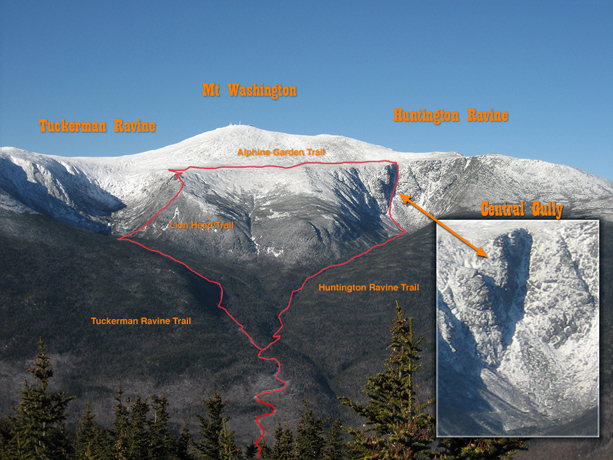Closer look, crown of Friday's Central Gully #huntingtonravine human triggered #avalanche . Even the minimal snow in our terrain can produce an avalanche. #earlyseason #mwac pic.twitter.com/whMDUGOL4d
— MWAC (@Avalanchecenter) December 2, 2017
According to the Mount Washington Avalanche Center, an early season avalanche occurred on Mount Washington, NH on Friday. The slide took place in the Central Gully area of Huntington Ravine. It was reported that the crown of the avalanche measured 18″.

Thankfully, no one was injured in the slide, but it prompted Mount Washington Avalanche Center to issue an early season advisory. Even though the snow isn’t that deep, it doesn’t mean that avalanches can’t occur. They may be small in size, but they still pose a threat to your safety.

Mount Washington Advisory:
This is an informational bulletin and does not expire. A new bulletin will be posted when conditions warrant or be replaced by a General Bulletin or Avalanche Advisory.
Cold temperatures, snow and mixed precipitation have created winter hazards on the mountain. Our forecast area contains some smooth snow surfaces where an avalanche could occur. While likely to be small in size, any avalanche could be particularly dangerous due to the many obstacles in the slide path. These hazards include falling over a cliff, or hitting boulders and small trees. Additionally, cold temperatures and high winds generally grow colder and stronger as you gain elevation, so be prepared for full winter conditions when planning a trip to the summit. Here are some things to keep in mind as you prepare:
- The Tuckerman Ravine Trail through Tuckerman Ravine crosses under and through several avalanche paths as it winds its way through the Bowl and across the Headwall. Be prepared to assess the stability of these slopes and to travel across ice directly over cliffs if you choose to travel this route. The summer Lion Head Trail currently has greatly reduced risk of avalanche and consequence in the event of a fall and is a safer route to the summit. The Lion Head Winter Route will be the preferred route when enough snow falls on the Lion Head summer route to create a bed surface and avalanche concerns.
- Wind slabs develop quickly in our terrain. Snow squalls or wind following a storm can create wind or storm slabs on any smooth, steep slope on your intended climb or ski descent. Evaluate these slopes before you commit to them and consider the consequences of being swept off your feet. Are there obstacles to hit in your path? Can you protect yourself when climbing from steep ice onto lower angled, snow covered ice?
- Plentiful ice can be found in both Ravines, particularly on shady aspects. Conditions can change quickly with enough sun and warm temperatures or cold and blowing snow. Be prepared to change objectives by having alternative plans. People above you can create significant hazards. Ice fall and dry-loose avalanches are a threat to consider on any climb.
Now is a good time to pull out your avalanche beacon, probe and shovel if you haven’t already. Practice single and multiple burial scenarios with your friends and partners. You don’t need snow on the ground with weighted plastic grocery bags as decoys. Practice your trailhead function check and do a range check. Is your beacon firmware up to date? Is your beacon old and unreliable? Have you practiced with your airbag pack? All of these avalanche rescue tools work best if you are skilled using them. Solid skills come with practice. Train your brain too. Avoiding being caught by an avalanche is your best strategy. Consider taking an avalanche class, wilderness first aid, first responder or rescue class and be self-sufficient in the field. Help can take a long time to arrive so be prepared to provide your own care and perform your own rescue.
Please Remember:
- Safe travel in avalanche terrain requires training and experience. This bulletin is just one tool to help you make your own decisions in avalanche terrain. You control your own risk by choosing where, when, and how you travel.
- For more information contact the Forest Service Snow Rangers, The Mount Washington Volunteer Ski Patrol, the AMC at the Pinkham Notch Visitor Center, or the caretakers at Hermit Lake Shelters or Harvard Cabin.
- Posted at 9:00 am on Friday, December 1, 2017. A new bulletin will be issued when conditions warrant.
Your title is miss leading. “Early” season avalanche? If large amounts of snow fall, it can slide. Stop spreading false information